


Framed or unframed, desk size to sofa size, printed by us in Arizona and Alabama since 2007. Explore now.
Shorpy is funded by you. Patreon contributors get an ad-free experience.
Learn more.

- Lofty addition
- In 1912
- Keenan Building
- Six years old
- Taken from the P.J. McArdle Roadway?
- It stood only 47 years
- Three track mind
- Incline to the right
- Reach for the sky, 1912 style
- No clean sweep
- Same Job Title, Same Face
- Sadly Lost
- Beautiful ...
- Where you get your kicks
- Aim High
- Pueblo Revival sisters
- Pueblo Neoclassicism
- Milk Man
- Regional dialect.
- Spielberg's inspiration
- Great Photo
- Loaf Story
- Do you still have the Rakes category?
- Could almost be a scene from the 1957 movie 'Hell Drivers'
- The Wages of Fear.
- Conspicuous by their absence
- Got Milk?
- All that aluminum
- No lefties
- Smoke 'em if you've got 'em
Print Emporium
Crossing Canal: 1890

New Orleans circa 1890. "St. Charles Hotel from Canal Street." 5x7 inch glass negative by William Henry Jackson. View full size.
Individual traffic on rails
There are some cities (in know Lisbon and Linz) that used special gauges in order to avoid carriage traffic on their tracks. This photo shows the reason quite well as the gig is just rerailed.
Horsecar History
Horse powered omnibuses (called horsecars) were very common in the 19th century.
The problem with horsecars was the horses. Specifically horse manure and urine. Horses could also panic, dragging the horsecar after them.
Most cities (including New Orleans) tried replacing horsecars with different solutions: ammonia engines, steam "dummies" (effectively a small steam engine inside a converted horsecar), battery powered cars, cable cars.
Eventually electric overhead powered streetcars using trolleys became the norm. In New Orleans, horsecars were replaced by overhead powered electric streetcars starting in 1893.
A few cities still have streetcars (San Francisco), but buses pretty much replaced them by the 1960s.
Look Closely
Those streetcars have some real horsepower!
























On Shorpy:
Today’s Top 5